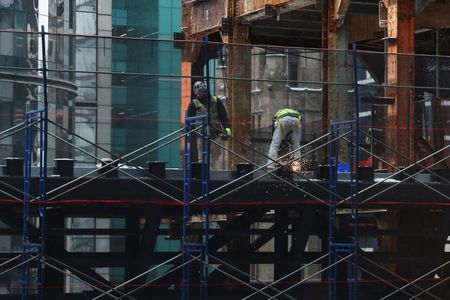By Lucia Mutikani
WASHINGTON (Reuters) – U.S. labor costs rose less than expected in the fourth quarter and the annual increase was the smallest in two years, signs of moderating wage inflation that could give the Federal Reserve room to start cutting interest rates by June.
Compensation costs growth is slowing as labor market conditions ease in response to the U.S. central bank’s tight monetary policy stance. Government data on Tuesday showed Americans were becoming less enthusiastic about job-hopping, with the number of people quitting their jobs near a three-year low in December, a trend that could further slow wage inflation.
The Fed kept rates unchanged on Wednesday against the backdrop of a resilient economy, which is being anchored by the labor market through consumer spending. Its policy statement gave no hint that a rate cut was imminent.
“Not great news for our pay checks, but good news for inflation and the prospect of meaningful Fed policy easing,” said James Knightley, chief international economist at ING in New York.
The Employment Cost Index (ECI), the broadest measure of labor costs, increased 0.9% last quarter, the Labor Department’s Bureau of Labor Statistics said on Wednesday. That was the smallest quarterly gain since the second quarter of 2021 and followed a 1.1% advance in the July-September period.
Economists polled by Reuters had forecast the ECI rising 1.0%. Labor costs increased 4.2% year-on-year, the smallest rise since the fourth quarter of 2021, after climbing 4.3% in the third quarter.
While still elevated by historical standards, annual compensation growth has slowed after peaking at 5.1% in 2022. Labor costs rose at a 3.5% rate on an annualized basis last quarter, which economists said was consistent with the Fed’s 2% inflation target, if worker productivity maintained its recent upward trend.
The labor market is gradually easing after a robust performance in 2022. There were 1.4 job openings for every unemployed person in December. Though this ratio was steady from November, it has declined from two jobs in March 2022.
Financial markets have lowered the odds of a March rate cut to below zero. The U.S. central bank has raised its policy rate by 525 basis points to the current 5.25%-5.50% range since March 2022. The ECI is viewed by policymakers as one of the better measures of labor market slack and a predictor of core inflation because it adjusts for composition and job-quality changes.
“The door is open for a cut and the Fed will quickly walk through it if activity or labor market data weaken,” said Andrew Hollenhorst, chief U.S. economist at Citigroup in New York.
The dollar fell against a basket of currencies. U.S. Treasury prices rose. Stocks on Wall Street slipped.
BIG GAINS FOR UNION WORKERS
Wages rose 0.9% in the fourth quarter, also the smallest gain since the second quarter of 2021, after increasing 1.2% in the prior three months. They rose 4.3% year-on-year after advancing 4.6% in the July-September quarter.
Private sector wages also climbed 0.9%. They rose 4.3% year-on-year and slowed from an increase of 5.1% compared to the same period in 2022. There was a large quarterly increase in transportation and warehousing wages. Manufacturing also posted notable gains. The United Auto Workers and Teamsters unions secured large pay raises for their members last year.
But wage gains slowed for retail workers as well as those in financial activities, education and health services.
Annual compensation costs rose 4.5% for union workers and were up 4.0% for non-union workers. Wages and salaries for union workers advanced 5.4% compared to the 4.2% rise for non-union workers. State and local government wages increased 1.1% after surging 1.8% in the prior quarter. They rose 4.7% year-on-year after rising 4.8% in the third quarter.
Inflation-adjusted wages for all workers gained 1.0% year-on-year after rising 0.9% in the third quarter. The increase in purchasing power should help to underpin consumer spending and could shield the economy from recession.
Benefits increased 0.7% after gaining 0.9% in the July-September period. They rose 3.8% year-on-year.
Cooling wage inflation was also evident in the ADP National Employment Report on Wednesday, which showed pay for people staying in their jobs rising 5.2% year-over-year in January after increasing 5.4% in December.
Wages for workers changing jobs rose 7.2%, the smallest gain since May 2021, after increasing 8.0% in December.
The ADP report also showed private payrolls increased by 107,000 jobs in January after rising 158,000 in December. Economists had forecast private payrolls rising 145,000.
The smaller-than-expected increase, however, likely overstates the slowing labor market momentum.
According to a Reuters survey of economists, the Labor Department’s Bureau of Labor Statistics is expected to report on Friday that private payrolls rose by 155,000 jobs in January. Total nonfarm payrolls are estimated to have increased by 180,000 jobs after rising 216,000 in the prior month.
“We do not place much weight on the ADP miss because of ADP’s negative correlation with BLS private payrolls,” economists at Goldman Sachs wrote in a note. “We also expect a larger boost to the BLS measure from fewer end-of-year layoffs, which ADP data do not generally capture.”
(Reporting By Lucia Mutikani; Editing by Andrea Ricci and Chris Reese)


